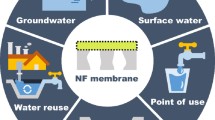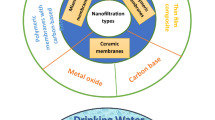Abstract
Nanofiltration (NF) using loose membranes has a high application potential for advanced treatment of drinking water by selectively removing contaminants from the water, while membrane fouling remains one of the biggest problems of the process. This paper reported a seven-month pilot study of using a loose NF membrane to treat a sand filtration effluent which had a relatively high turbidity (∼0.4 NTU) and high concentrations of organic matter (up to 5 mg/L as TOC), hardness and sulfate. Results showed that the membrane demonstrated a high rejection of TOC (by<90%) and a moderately high rejection of two pesticides (54%–82%) while a moderate rejection of both calcium and magnesium (∼45%) and a low rejection of total dissolved solids (∼27%). The membrane elements suffered from severe membrane fouling, with the membrane permeance decreased by 70% after 85 days operation. The membrane fouling was dominated by organic fouling, while biological fouling was moderate. Inorganic fouling was mainly caused by deposition of aluminum-bearing substances. Though inorganic foulants were minor contents on membrane, their contribution to overall membrane fouling was substantial. Membrane fouling was not uniform on membrane. While contents of organic and inorganic foulants were the highest at the inlet and outlet region, respectively, the severity of membrane fouling increased from the inlet to the outlet region of membrane element with a difference higher than 30%. While alkaline cleaning was not effective in removing the membrane foulants, the use of ethylenediamine tetraacetate (EDTA) at alkaline conditions could effectively restore the membrane permeance.

Similar content being viewed by others
References
Bandini S, Vezzani D (2003). Nanofiltration modeling: the role of dielectric exclusion in membrane characterization. Chemical Engineering Science, 58(15): 3303–3326
Bellona C, Drewes J E, Xu P, Amy G (2004). Factors affecting the rejection of organic solutes during NF/RO treatment: A literature review. Water Research, 38(12): 2795–2809
Beyer F, Rietman B M, Zwijnenburg A, van den Brink P, Vrouwenvelder J S, Jarzembowska M, Laurinonyte J, Stams A J M, Plugge C M (2014). Long-term performance and fouling analysis of full-scale direct nanofiltration (NF) installations treating anoxic groundwater. Journal of Membrane Science, 468: 339–348
Choi Y H, Nason J A, Kweon J H (2013). Effects of aluminum hydrolysis products and natural organic matter on nanofiltration fouling with PACl coagulation pretreatment. Separation and Purification Technology, 120: 78–85
Cyna B, Chagneau G, Bablon G, Tanghe N (2002). Two years of nanofiltration at the Mery-sur-Oise plant, France. Desalination, 147 (1–3): 69–75
Fan X Q, Gao J, Li W C, Huang J, Yu G (2020). Determination of 27 pharmaceuticals and personal care products (PPCPs) in water: The benefit of isotope dilution. Frontiers of Environmental Science & Engineering, 14(1): 8
Fritzmann C, Löwenberg J, Wintgens T, Melin T (2007). State-of-the-art of reverse osmosis desalination. Desalination, 216(1–3): 1–76
Frolund B, Griebe T, Nielsen P H (1995). Enzymatic-activity in the activated sludge floc matrix. Applied Microbiology and Biotechnology, 43(4): 755–761
Gabelich C J, Chen W R, Yun T I, Coffey B M, Suffet I H (2005). The role of dissolved aluminum in silica chemistry for membrane processes. Desalination, 180(1–3): 307–319
Gabelich C J, Ishida K P, Gerringer F W, Evangelista R, Kalyan M, Suffet I H (2006). Control of residual aluminum from conventional treatment to improve reverse osmosis performance. Desalination, 190 (1–3): 147–160
Gerhardt P, Murray R G E, Wood W A, Krieg N R (1994). Methods for General and Molecular Bacteriology. Washington, DC: American Society for Microbiology
Guo Y, Li T Y, Xiao K, Wang X M, Xie Y F (2020). Key foulants and their interactive effect in organic fouling of nanofiltration membranes. Journal of Membrane Science, 610: 118252
Her N, Amy G, Plottu-Pecheux A, Yoon Y (2007). Identification of nanofiltration membrane foulants. Water Research, 41(17): 3936–3947
Houari A, Seyer D, Kecili K, Heim V, Martino P D (2013). Kinetic development of biofilm on NF membranes at the Mery-sur-Oise plant, France. Biofouling, 29(2): 109–118
Kimura K, Okazaki S, Ohashi T, Watanabe Y (2016). Importance of the co-presence of silica and organic matter in membrane fouling for RO filtering MBR effluent. Journal of Membrane Science, 501: 60–67
Kolpin D W, Furlong E T, Meyer M T, Thurman E M, Zaugg S D, Barber L B, Buxton H T (2002). Pharmaceuticals, hormones, and other organic wastewater contaminants in US streams, 1999–2000: A national reconnaissance. Environmental Science & Technology, 36 (6): 1202–1211
Le Gouellec Y A, Elimelech M (2002). Calcium sulfate (gypsum) scaling in nanofiltration of agricultural drainage water. Journal of Membrane Science, 205(1–2): 279–291
Liu Y L, Wang X M, Yang H W, Xie Y F, Huang X (2019). Preparation of nanofiltration membranes for high rejection of organic micro-pollutants and low rejection of divalent cations. Journal of Membrane Science, 572: 152–160
Luo J Q, Wan Y H (2013). Effects of pH and salt on nanofiltration—A critical review. Journal of Membrane Science, 438: 18–28
Miller R G, Kopfler F C, Kelty K C, Stober J A, Ulmer N S (1984). The occurrence of aluminum in drinking water. Journal- American Water Works Association, 76(1): 84–91
Nriagu J, Darroudi F, Shomar B (2016). Health effects of desalinated water: Role of electrolyte disturbance in cancer development. Environmental Research, 150: 191–204
Ohno K, Matsui Y, Itoh M, Oguchi Y, Kondo T, Konno Y, Matsushita T, Magara Y (2010). NF membrane fouling by aluminum and iron coagulant residuals after coagulation-MF pretreatment. Desalination, 254(1–3): 17–22
Plakas K V, Karabelas A J (2008). Membrane retention of herbicides from single and multi-solute media: The effect of ionic environment. Journal of Membrane Science, 320(1–2): 325–334
Radjenović J, Petrovic M, Ventura F, Barcelo D (2008). Rejection of pharmaceuticals in nanofiltration and reverse osmosis membrane drinking water treatment. Water Research, 42(14): 3601–3610
Reungoat J, Escher B I, Macova M, Argaud F X, Gernjak W, Keller J (2012). Ozonation and biological activated carbon filtration of wastewater treatment plant effluents. Water Research, 46(3): 863–872
Sari M A, Chellam S (2016). Reverse osmosis fouling during pilot-scale municipal water reuse: Evidence for aluminum coagulant carryover. Journal of Membrane Science, 520: 231–239
Sharp E L, Parsons S A, Jefferson B (2006). Seasonal variations in natural organic matter and its impact on coagulation in water treatment. Science of the Total Environment, 363(1–3): 183–194
Sheikholeslami R, Al-Mutaz I S, Koo T, Young A (2001). Pretreatment and the effect of cations and anions on prevention of silica fouling. Desalination, 139(1–3): 83–95
Siebdrath N, Ding W, Pietsch E, Kruithof J, Uhl W, Vrouwenvelder J (2017). Construction and validation of a long-channel membrane test cell for representative monitoring of performance and characterization of fouling over the length of spiral-wound membrane modules. Desalination and Water Treatment, 89: 1–16
Ventresque C, Gisclon V, Bablon G, Chagneau G (2000). An outstanding feat of modern technology: the Mery-sur-Oise Nanofiltration Treatment Plant (340,000 m3/d). Desalination, 131(1–3): 1–16
Vrouwenvelder J S, Manolarakis S A, van der Hoek J P, van Paassen J A M, van der Meer W G J, van Agtmaal J M C, Prummel H D M, Kruithof J C, van Loosdrecht M C M (2008). Quantitative biofouling diagnosis in full scale nanofiltration and reverse osmosis installations. Water Research, 42(19): 4856–4868
Vrouwenvelder J S, van Paassen J A M, Kruithof J C, van Loosdrecht M C M (2009). Sensitive pressure drop measurements of individual lead membrane elements for accurate early biofouling detection. Journal of Membrane Science, 338(1–2): 92–99
Wang X M, Li B, Zhang T, Li X Y (2015a). Performance of nanofiltration membrane in rejecting trace organic compounds: Experiment and model prediction. Desalination, 370: 7–16
Wang X M, Waite T D (2009). Role of gelling soluble and colloidal microbial products in membrane fouling. Environmental Science & Technology, 43(24): 9341–9347
Wang X M, Yang H W, Li Z Y, Yang S X, Xie Y F (2015b). Pilot study for the treatment of sodium and fluoride contaminated groundwater by using high-pressure membrane systems. Frontiers of Environmental Science & Engineering, 9(1): 155–163
Westerhoff P, Yoon Y, Snyder S, Wert E (2005). Fate of endocrinedisruptor, pharmaceutical, and personal care product chemicals during simulated drinking water treatment processes. Environmental Science & Technology, 39(17): 6649–6663
Yan M Q, Luo T T, Li N, Korshin G V (2019). Monitoring the kinetics of reactions between natural organic matter and Al(III) ions using differential absorbance spectra. Chemosphere, 235: 220–226
Zhang T, Liu H Z, Zhang Y Y, Sun W J, Ao X W (2020). Comparative genotoxicity of water processed by three drinking water treatment plants with different water treatment procedures. Frontiers of Environmental Science & Engineering, 14(3): 39
Zhao X H, Wu Y H, Zhang X, Tong X, Yu T, Wang Y H, Ikuno N, Ishii K, Hu H Y (2019). Ozonation as an efficient pretreatment method to alleviate reverse osmosis membrane fouling caused by complexes of humic acid and calcium ion. Frontiers of Environmental Science & Engineering, 13(4): 55
Zhao Y Y, Kong F X, Wang Z, Yang H W, Wang X M, Xie Y F, Waite T D (2017). Role of membrane and compound properties in affecting the rejection of pharmaceuticals by different RO/NF membranes. Frontiers of Environmental Science & Engineering, 11(6): 20
Zhu F, Yao Z J, Ji W L, Liu D Y, Zhang H, Li A M, Huo Z L, Zhou Q (2020). An efficient resin for solid-phase extraction and determination by UPLCMS/MS of 44 pharmaceutical personal care products in environmental waters. Frontiers of Environmental Science & Engineering, 14(3): 51
Acknowledgements
We acknowledge the funding for this research provided by the National Natural Science Foundation of China (Grant Nos. 51761125013 and 51678331).
Author information
Authors and Affiliations
Corresponding author
Additional information
Highlights
• A pilot study was conducted for drinking water treatment using loose NF membranes.
• The membranes had very high rejection of NOM and medium rejection of Ca2+/Mg2+.
• Organic fouling was dominant and contribution of inorganic fouling was substantial.
• Both organic and inorganic fouling had spatial non-uniformity on membrane surface.
• Applying EDTA at basic conditions was effective in removing membrane fouling.
Supporting materials
Rights and permissions
About this article
Cite this article
Liu, D., Cabrera, J., Zhong, L. et al. Using loose nanofiltration membrane for lake water treatment: A pilot study. Front. Environ. Sci. Eng. 15, 69 (2021). https://doi.org/10.1007/s11783-020-1362-6
Received:
Revised:
Accepted:
Published:
DOI: https://doi.org/10.1007/s11783-020-1362-6




